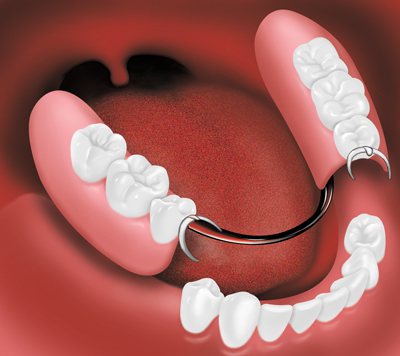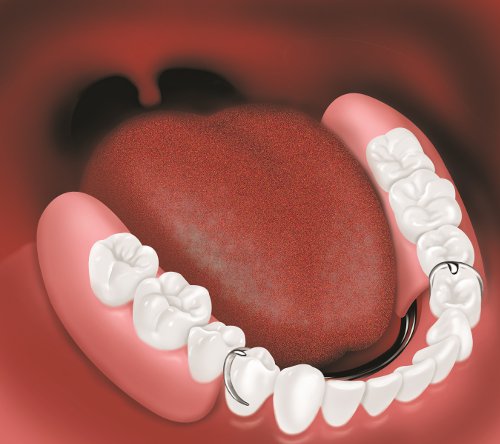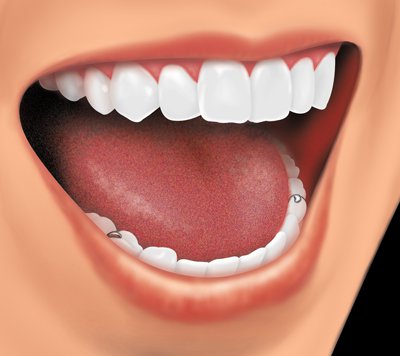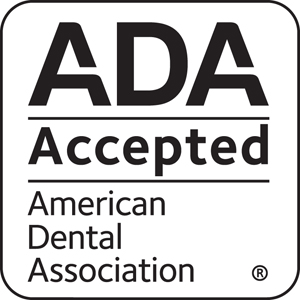Partial Dentures
You can smile confidently again with the help of a custom, natural-looking partial denture created just for you. Partial dentures are a great solution if you are missing some teeth because the denture fills the gaps in your smile and helps make talking and eating easier.
According to the American Dental Association:
Removable Partial Dentures
If you have missing teeth, a removable partial denture is one way to replace them.
Partial dentures have several benefits. They can make it easier for you to chew food. They can also help you speak better if your speech has changed due to missing teeth. Removable partial dentures can also support cheeks and lips so the face does not sag and make you look older.
Other reasons to replace missing teeth
When you lose a tooth, the nearby teeth may tilt or drift into the empty space. The teeth in the other jaw may also shift up or down toward the space. This can affect your bite and place more stress on your teeth and jaws. You may find it harder to clean teeth that have shifted, which can lead to tooth decay and gum disease. That is why it is important to replace missing teeth.
How partial dentures work
Removable partial dentures usually have replacement teeth fixed to an acrylic base that matches the color of your gums. The acrylic base may cover a metal framework. Partial dentures often have some form of clasp that attaches to your natural teeth. This holds the denture in place.
Your dentist may also recommend crowns, or “caps,” on some of your natural teeth. Crowns can improve the way a removable partial denture fits your mouth. Ask your dentist which kind of removable partial denture is right for you.
 |
 |
 |
| Partial denture above gum | Partial denture in place | Partial denture in mouth (rest seats on two teeth can be seen) |
Your New Removable Partial Denture
It takes practice to put in and take out a removable partial denture. It may feel a bit odd or tight for the first few weeks. But in time, you should get used to it. Never force the denture into place by biting down. This could bend or break the clasps or damage your teeth. If you have a problem with your new partial denture, talk with your dentist.
You should not wear your removable partial denture 24 hours a day. Your dentist may tell you to take out the partial denture at bedtime and put it back in when you wake up. Usually your dentist will make follow-up appointments to look for pressure points or sore spots. He or she will adjust your denture so it fits comfortably.
Eating and Speaking
When you replace missing teeth, eating is much easier. But it takes practice. Here are some things that can help:
- Begin by eating soft foods cut into small pieces.
- Chew on both sides of the mouth to keep the pressure even.
- Do not eat very sticky or hard foods, and do not chew gum.
If you have missing teeth, wearing a removable partial denture can help you speak more clearly. If you find that some words are hard to say at first, try reading out loud in front of a mirror. With time and practice, you should be able to speak well.
Caring for Your Removable Partial Denture
Like natural teeth, you must take good care of your removable partial denture. Here are some tips:
- Clean your partial denture each day. Take it out of your mouth and rinse off food particles. Wet the brush and put the denture cleaner on it. Or you can use a little bit of liquid dish soap.
- Brush all of the denture surfaces gently. It is best to use a special brush made for cleaning dentures, but you can use a toothbrush with soft bristles.
- Do not use toothpaste to clean dentures. Some toothpastes have abrasive particles that can damage the denture base and teeth.
- When brushing your partial denture, hold over a folded towel or a sink filled with cool water. Your removable partial denture is very delicate and can break easily.
- Keep your partial denture in water or denture soaking solution when you are not wearing it. Do not let it dry out or it can lose its shape.
- Rinse the partial denture well after using any denture cleanser. It may contain chemicals that should not go in the mouth.
 Look for denture cleansers with the American Dental Association Seal of Acceptance, a symbol of safety and effectiveness.
Look for denture cleansers with the American Dental Association Seal of Acceptance, a symbol of safety and effectiveness.- Brush your natural teeth with fluoride toothpaste twice each day. Floss or use another between-the-teeth cleaner once a day.
- Take extra care when you clean teeth that fit under the denture’s metal clasps. Your dentist or dental hygienist can show you how to properly brush and clean between the teeth.
- Keep your denture away from curious children and pets when you are not wearing it.
Adjustments and Repairs
As you get older, the fit of your removable partial denture can change. Your jaw bone can shrink, making a space under the denture. Food can get trapped. The denture clasps also may get loose from normal wear.
If your partial denture needs adjusting, do not adjust it yourself. You can harm both the denture and your health. And do not use household glues to repair the partial, because they can have harmful chemicals.
See your dentist as soon as possible if your removable partial denture breaks, cracks or chips or if one of the teeth becomes loose. Also, your partial denture may need to be adjusted if you lose one of the supporting natural teeth. Sometimes dentists can make the repairs, often on the same day. Complex repairs can take longer. The sooner you make an appointment, the sooner you have a well-fitting partial denture again.
Your dentist will tell you how often to go for dental visits. Regular exams and professional cleanings are very important to keep a healthy smile.
This ADA educational message displayed by permission.

